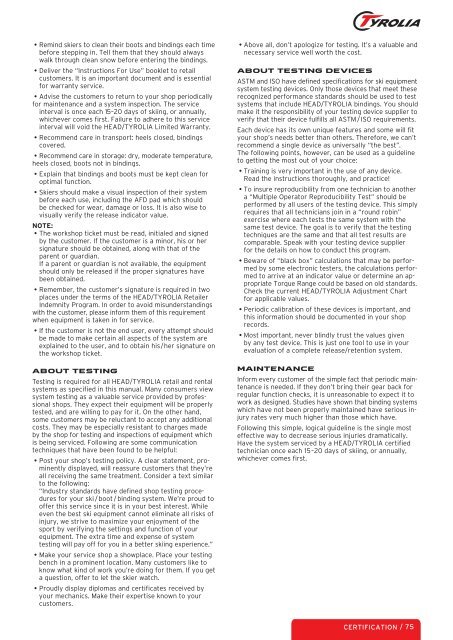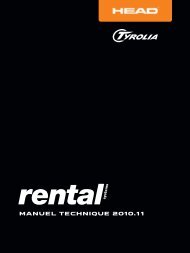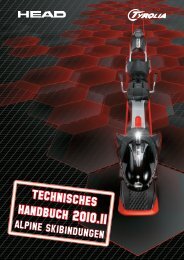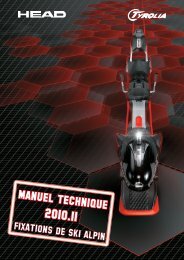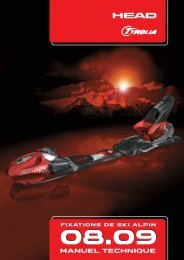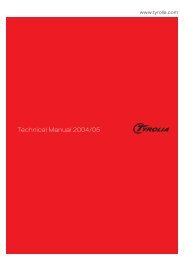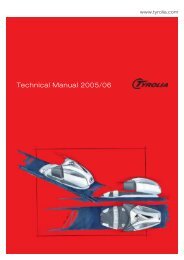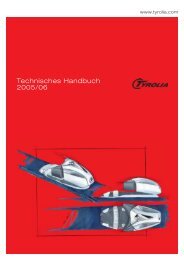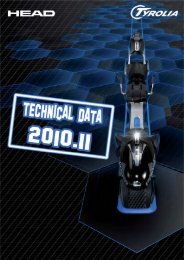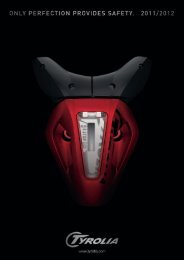You also want an ePaper? Increase the reach of your titles
YUMPU automatically turns print PDFs into web optimized ePapers that Google loves.
• Remind skiers to clean their boots and bindings each time<br />
before stepping in. Tell them that they should always<br />
walk through clean snow before entering the bindings.<br />
• Deliver the “Instructions For Use” booklet to retail<br />
customers. It is an important document and is essential<br />
for warranty service.<br />
• Advise the customers to return to your shop periodically<br />
for maintenance and a system inspection. The service<br />
interval is once each 15–20 days of skiing, or annually,<br />
whichever comes first. Failure to adhere to this service<br />
interval will void the HEAD/TYROLIA Limited Warranty.<br />
• Recommend care in transport: heels closed, bindings<br />
covered.<br />
• Recommend care in storage: dry, moderate temperature,<br />
heels closed, boots not in bindings.<br />
• Explain that bindings and boots must be kept clean for<br />
optimal function.<br />
• Skiers should make a visual inspection of their system<br />
before each use, including the AFD pad which should<br />
be checked for wear, damage or loss. It is also wise to<br />
visually verify the release indicator value.<br />
NOTE:<br />
• The workshop ticket must be read, initialed and signed<br />
by the customer. If the customer is a minor, his or her<br />
signature should be obtained, along with that of the<br />
parent or guardian.<br />
If a parent or guardian is not available, the equipment<br />
should only be released if the proper signatures have<br />
been obtained.<br />
• Remember, the customer’s signature is required in two<br />
places under the terms of the HEAD/TYROLlA Retailer<br />
Indemnity Program. In order to avoid misunderstandings<br />
with the customer, please inform them of this requirement<br />
when equipment is taken in for service.<br />
• If the customer is not the end user, every attempt should<br />
be made to make certain all aspects of the system are<br />
explained to the user, and to obtain his/her signature on<br />
the workshop ticket.<br />
ABOUT TESTING<br />
Testing is required for all HEAD/TYROLIA retail and rental<br />
systems as specified in this manual. Many consumers view<br />
system testing as a valuable service provided by professional<br />
shops. They expect their equipment will be properly<br />
tested, and are willing to pay for it. On the other hand,<br />
some customers may be reluctant to accept any additional<br />
costs. They may be especially resistant to charges made<br />
by the shop for testing and inspections of equipment which<br />
is being serviced. Following are some communication<br />
techniques that have been found to be helpful:<br />
• Post your shop’s testing policy. A clear statement, prominently<br />
displayed, will reassure customers that they’re<br />
all receiving the same treatment. Consider a text similar<br />
to the following:<br />
“Industry standards have defined shop testing procedures<br />
for your ski / boot / binding system. We’re proud to<br />
offer this service since it is in your best interest. While<br />
even the best ski equipment cannot eliminate all risks of<br />
injury, we strive to maximize your enjoyment of the<br />
sport by verifying the settings and function of your<br />
equipment. The extra time and expense of system<br />
testing will pay off for you in a better skiing experience.”<br />
• Make your service shop a showplace. Place your testing<br />
bench in a prominent location. Many customers like to<br />
know what kind of work you’re doing for them. If you get<br />
a question, offer to let the skier watch.<br />
• Proudly display diplomas and certificates received by<br />
your mechanics. Make their expertise known to your<br />
customers.<br />
• Above all, don’t apologize for testing. It’s a valuable and<br />
necessary service well worth the cost.<br />
ABOUT TESTING DEVICES<br />
ASTM and ISO have defined specifications for ski equipment<br />
system testing devices. Only those devices that meet these<br />
recognized performance standards should be used to test<br />
systems that include HEAD/TYROLIA bindings. You should<br />
make it the responsibility of your testing device supplier to<br />
verify that their device fulfills all ASTM/ISO requirements.<br />
Each device has its own unique features and some will fit<br />
your shop’s needs better than others. Therefore, we can’t<br />
recommend a single device as universally “the best”.<br />
The following points, however, can be used as a guideline<br />
to getting the most out of your choice:<br />
• Training is very important in the use of any device.<br />
Read the instructions thoroughly, and practice!<br />
• To insure reproducibility from one technician to another<br />
a “Multiple Operator Reproducibility Test” should be<br />
performed by all users of the testing device. This simply<br />
requires that all technicians join in a “round robin”<br />
exercise where each tests the same system with the<br />
same test device. The goal is to verify that the testing<br />
techniques are the same and that all test results are<br />
comparable. Speak with your testing device supplier<br />
for the details on how to conduct this program.<br />
• Beware of “black box” calculations that may be performed<br />
by some electronic testers, the calculations performed<br />
to arrive at an indicator value or determine an appropriate<br />
Torque Range could be based on old standards.<br />
Check the current HEAD/TYROLIA Adjustment Chart<br />
for applicable values.<br />
• Periodic calibration of these devices is important, and<br />
this information should be documented in your shop<br />
records.<br />
• Most important, never blindly trust the values given<br />
by any test device. This is just one tool to use in your<br />
evaluation of a complete release/retention system.<br />
MAINTENANCE<br />
Inform every customer of the simple fact that periodic maintenance<br />
is needed. If they don’t bring their gear back for<br />
regular function checks, it is unreasonable to expect it to<br />
work as designed. Studies have shown that binding systems<br />
which have not been properly maintained have serious injury<br />
rates very much higher than those which have.<br />
Following this simple, logical guideline is the single most<br />
effective way to decrease serious injuries dramatically.<br />
Have the system serviced by a HEAD/TYROLIA certified<br />
technician once each 15–20 days of skiing, or annually,<br />
whichever comes first.<br />
CERTIFICATION / 75


